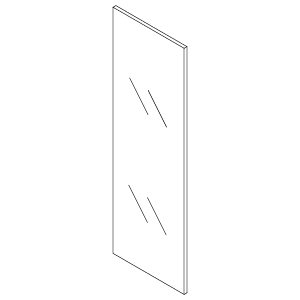PRODUCT SIZE
246x295x4mm
![]()
GEOLOGICAL PERIOD
Present — Ordovician
Present — 485 MYA
COMPOSITION
75% Sand
15% Soda ash
10% Limestone
246x295x4mm

GEOLOGICAL PERIOD
Present — Ordovician
Present — 485 MYA
COMPOSITION
75% Sand
15% Soda ash
10% Limestone
GEOLOGICAL BIO
A geology of glass takes us far beyond the material culture of modernity. Its transparency obscures a history of rocks and minerals that have been faulting and eroding since the Paleozoic Era to form sand. In glass, they gather once again, this time as a fragile, amorphous solid.
These geologic shards of “liquid sand” also reflect an industrial-era desire to standardize, purify, and expand material technologies and products for factory and everyday applications, as with the development of tempered (safety) glass in the mid-19th century, or float glass a century later.
While new glass continues to be specified around the world, recycled glass is in low demand even though it can be recycled endlessly without degrading. This is because of "contamination" of iron content in second-hand float glass, creating panes that are considered optically undesirable. A geological perspective might shift consumer norms of visual clarity toward an aesthetics of grainier, cloudier glass.
See also Fiberglass Insulation.
EXTRACTION / MANUFACTURING PROCESS
Melt ingredients ︎︎︎ mix to right proportion ︎︎︎ fly batch to a furnace heated to 1500°C ︎︎︎ fly composition into "float bath" ︎︎︎ leave it at 650°C as a solid ribbon shape ︎︎︎ add coatings ︎︎︎ annealing: allow glass to cool slowly to remove internal stresses ︎︎︎ inspect pieces (identify air bubbles, stresses, grains of sand, etc.) ︎︎︎ cut to retail size ︎︎︎ pack and ship
<taken from the CL-MaterialDatabase spreadsheet>
A geology of glass takes us far beyond the material culture of modernity. Its transparency obscures a history of rocks and minerals that have been faulting and eroding since the Paleozoic Era to form sand. In glass, they gather once again, this time as a fragile, amorphous solid.
These geologic shards of “liquid sand” also reflect an industrial-era desire to standardize, purify, and expand material technologies and products for factory and everyday applications, as with the development of tempered (safety) glass in the mid-19th century, or float glass a century later.
While new glass continues to be specified around the world, recycled glass is in low demand even though it can be recycled endlessly without degrading. This is because of "contamination" of iron content in second-hand float glass, creating panes that are considered optically undesirable. A geological perspective might shift consumer norms of visual clarity toward an aesthetics of grainier, cloudier glass.
See also Fiberglass Insulation.
EXTRACTION / MANUFACTURING PROCESS
Melt ingredients ︎︎︎ mix to right proportion ︎︎︎ fly batch to a furnace heated to 1500°C ︎︎︎ fly composition into "float bath" ︎︎︎ leave it at 650°C as a solid ribbon shape ︎︎︎ add coatings ︎︎︎ annealing: allow glass to cool slowly to remove internal stresses ︎︎︎ inspect pieces (identify air bubbles, stresses, grains of sand, etc.) ︎︎︎ cut to retail size ︎︎︎ pack and ship
<taken from the CL-MaterialDatabase spreadsheet>
